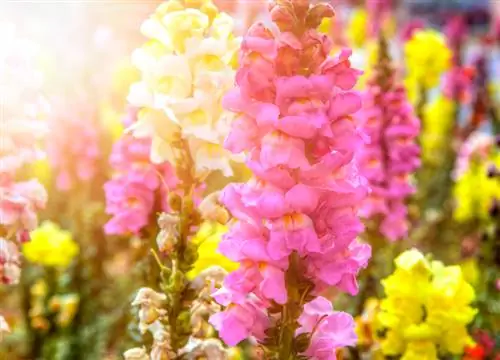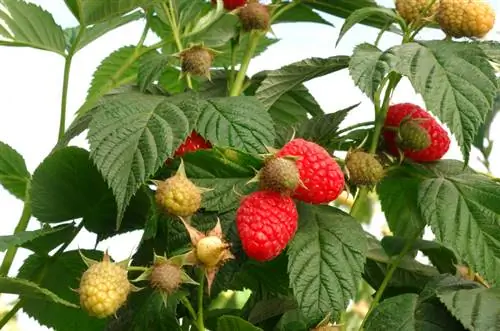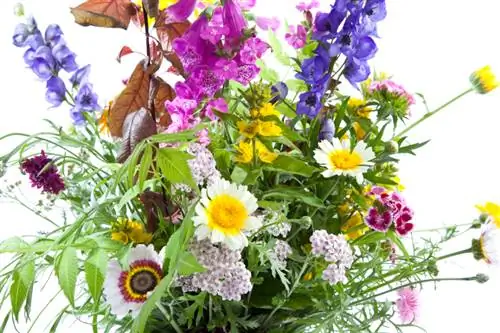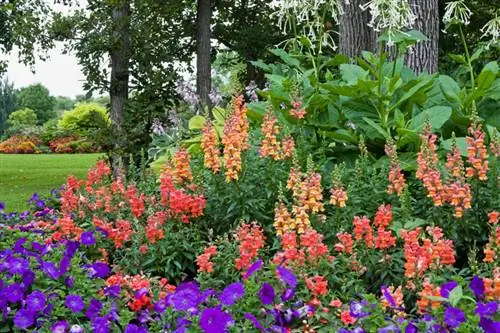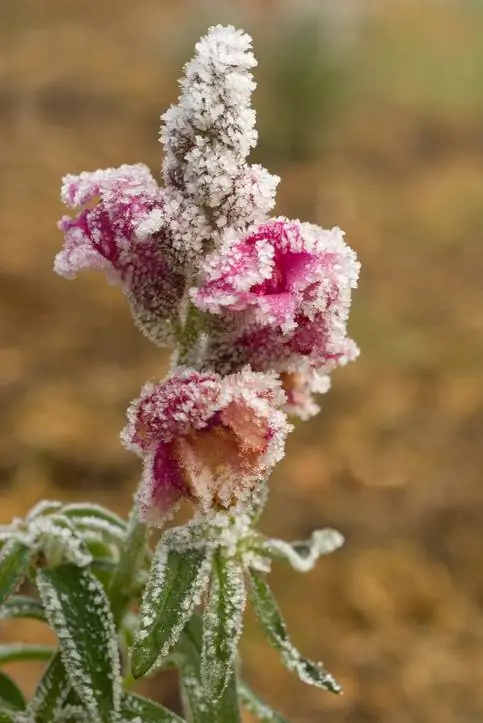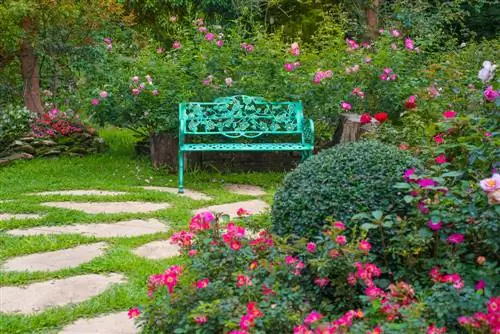- Author admin [email protected].
- Public 2023-12-25 17:45.
- Last modified 2025-01-23 11:20.
We associate snapdragons with an everlasting summer, full of colorful colors. Thanks to the different growth heights, the enchanting summer flowers decorate the flower box, while the long-stemmed beauties stand out as backdrops in the perennial bed or vase decorations. If you know what you're looking for, the nostalgic pieces of jewelry will guide you safely through the winter. The following answers to frequently asked questions provide all information about successful cultivation.
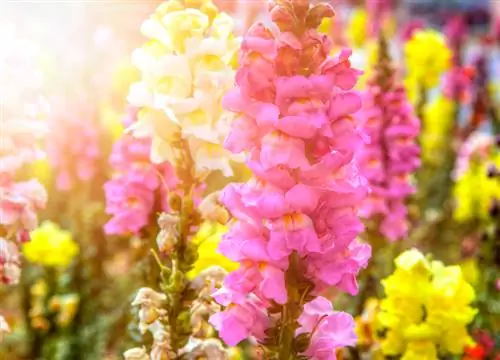
When and how do snapdragons bloom best?
Snapdragons are colorful summer flowers that bloom from June to October/November. They thrive best in sunny, warm and protected locations in humus-rich, well-drained soil. Regular watering, fertilizing and removing wilted flower stems promote lush flowering.
Planting Loewenmaeulchen correctly
For snapdragons, the starting signal for planting is mid/late May at the earliest, as the young plants are extremely sensitive to cold. Place the potted root balls in a container of soft water while you prepare the soil in the sunny location. Depending on the desired number, dig small planting pits at a distance of 20-25 cm and mix compost with horn shavings into the soil. Plant one specimen at a time so deep that the root ball is just below the surface of the soil. Please do not tread the substrate hard, just press it with your hands to water generously.read more
Care tips
With this simple care program you can guide your snapdragons through a blooming summer season:
- If the soil is dry, water alternately with soft and normal water
- Fertilize the bed every 3-4 weeks with compost; Treat the pot with liquid fertilizer every 2 days
- Do not fertilize from September onwards if overwintering is planned
- Cut off withered flower stems to a hand's width above the ground to encourage repeat blooms
Are you cultivating a hardy variety or is your garden in a mild winter region? Then just dare to overwinter your Antirrhinum. Leave the leaves on the plant until spring and spread a thick layer of foliage, secured with pine fronds. After pruning, it is best to put potted flowers in their frost-free winter quarters.read more
Which location is suitable?
Snapdragons develop their summer abundance of flowers in a sunny, warm and protected location. Partially shaded locations are tolerated, but are accompanied by a reduced flower volume. The majestic varieties are best kept in a place protected from the wind so that their long stems are not knocked over. The Graces do not place any special demands on the quality of the soil. The flowers thrive in any good garden soil that is nutrient-rich, humus-rich and, above all, permeable.read more
The correct planting distance
You can draw magical garden pictures with snapdragons if you arrange the flowers in small groups. Due to their slim shape, we recommend a planting distance of 25-35 cm, regardless of the expected growth height. An exception are the majestic Antirrhinum majus, which have a corresponding size at a height of up to 120 cm. Here we recommend a planting distance of 50-60 cm.
What soil does the plant need?
So that the snapdragon can spread its strong root system unhindered, it is important to have loose, humus-rich and well-drained soil. In waterlogged locations with compacted clay soil you will wait in vain for the lavish flower candles. A neutral to slightly acidic pH value of 5.5 to 6.5 is beneficial for vitality and flower abundance. For cultivation in pots and flower boxes, we recommend rhododendron soil or a mix of flower and ericaceous soil, enriched with lava granules, pumice or perlite respiration flakes.
When is flowering time?
From June to October/November the mighty flower candles take center stage. Please cut wilted stems just above the ground to encourage the growth of new flower spikes. Leave the native foliage standing because it provides for the subsequent blooms. Now your summer flowers will gratefully accept a portion of compost or liquid fertilizer so that they can sprout again with fresh energy.read more
Cut Loewenmaeulchen correctly
Cut off a wilted flower candle in good time before the plant begins the vigorous growth of capsule fruits. Place the scissors just above the basal leaves from which the next floral column will rise. Give the autumn flowers enough time to self-sow before cutting them to a hand's width above the ground. In this way, a continuation of the flower show next year is ensured should a harsh winter ruin the plans for several years of cultivation. You then cut off the drawn leaves in early spring so that the next generation of Antirrhinum can thrive unhindered.read more
Water Lionmaeulchen
Thanks to their strong root system, snapdragons are well prepared for short-term dry periods. However, this burden should be the exception. Constant soil moisture is beneficial for growth and abundance of flowers. Water the flowers when the soil has dried out. Experience has shown that this is necessary more often in pots and balcony boxes than in beds, where Mother Nature contributes to the water supply with downpours. Ideally, you should water alternately with soft and normal water so that the lime content in the substrate does not accumulate to undesirable levels.
Fertilize Loewenmaeulchen properly
Organic fertilizers are ideal for supplying nutrients in the bed. From June to September, lightly work compost, horn shavings, bark humus, guano or horse manure into the soil with a rake every 3-4 weeks and water again. In pot cultivation, we recommend giving liquid fertilizer every 2 weeks.
Diseases
With their lavish flowers and leaves, snapdragons are welcome prey for the fungal spores of powdery mildew. However, the disease can only cause actual damage if the plant is weakened by neglect in care. In the early stages of infestation, a mix of water and fresh milk in a ratio of 9:1 has proven to be a good home remedy. In the advanced stage, cut off the infected plants and sow them directly in the bed. In the middle of summer, germination progresses quickly.
Wintering
Competent breeders have taken hobby gardeners' desire for perennial snapdragons to heart and developed hardy hybrids such as 'Pretty in Pink' or the stable F1 mix 'Sonnet'. If your garden is in a region with mild winters or the plants are in a niche with a mild microclimate, most Antirrhinum majus are suitable for multi-year cultivation. This is how you maneuver the flowers he althily through the cold season:
- Before the first frost, cut off the withered flower stems down to the native foliage
- Pile a 20 cm high layer of autumn leaves on the root disk, covered with needle twigs
- Do not cut off the leaves until early spring
Pots and flower boxes with snapdragons move to a frost-free winter quarters, such as the unheated stairwell, the bright basement room or the garage. Here the plants are watered every now and then so that the root ball does not dry out.read more
Propagate Loewenmaeulchen
The flower candles that have not been cut back produce clearly visible capsule fruits in autumn, full of seeds. Collect these, remove the seeds and, after a short drying phase, store them in a screw-top jar in a cool cellar until spring. This is how propagation works by sowing:
- Sow the seeds on moist seed soil between February and March
- Do not cover the light germinators, just press them down with a board
- Place in a heated indoor greenhouse in a partially shaded location
- At 20-25 degrees Celsius, germination occurs within 10-21 days
The strongest seedlings are transplanted into 8 cm pots if they have at least 2 pairs of leaves. Now it is important to place the small snapdragons in a slightly cooler place and gradually get them used to full sunlight. In mid/end of May, plant the offspring in the bed, pot or flower box.
Loewenmaeulchen in the pot
Cultivation in the pot is just as easy as for snapdragons in the bed. Rhododendron soil or a mix of commercially available potting soil and bog soil are suitable as a substrate. Add a few more handfuls of perlite or lava granules for good permeability. A few pieces of pottery above the bottom of the pot prevent harmful waterlogging. How to properly care for Antirrhinum:
- Watering with soft and normal water alternately as soon as the soil has dried
- Fertilize liquidly every 2 weeks from June to September
- Cut off wilted flower candles down to the basal leaves for rebloom
Before the first frost, carry the cut plants to a frost-free winter quarters. At temperatures between 5 and 10 degrees Celsius, water significantly less and do not apply any fertilizer.
Is snapdragon poisonous?
Its visual appearance already signals its botanical relationship with numerous speedwell plants. Therefore, the snapdragon is not completely harmless in terms of its ingredients. In fact, the summer flower is classified as a mildly poisonous plant because various glycosides and alkaloids are found in the plant sap and seed heads. Cultivation should therefore be avoided within the reach of small children and pets.read more
Beautiful varieties
- Twinny Appleblossom: Magnificent Antirrhinum majus with double, pink-white apple blossoms; Growth height 25-30 cm
- Pretty in Pink: Rare, hardy snapdragon in bright pink for borders and vases; Growth height 50-60 cm
- Royal Bride: Majestic, white-flowering noble variety that exudes an intoxicating scent; Growth height 80-90 cm
- Black Prince: Compact Antirrhinum nanum that presents its deep red flowers in beds and containers; Growth height 45 cm
- Rembrandt: Picturesque, noble variety that delights with two-tone, orange-gold flowers; Growth height 45-50 cm
- Bronze Dragon: A feast for the eyes with almost black leaves and purple-white marbled flowers; Growth height 30-35 cm
- Circus Clowns: Colorful mix of medium-sized snapdragons for beds and balconies; Growth height 40-45 cm
- Lucky Lips: Tightly upright snapdragon that boasts pink-white flowers; Growth height 80-90 cm
- Madame Butterfly: Charming, double-flowered, long-stemmed premium variety, ideal for the vase; Growth height 75-80 cm
- Chinese Lanterns: Innovative breeding of hanging snapdragons for hanging baskets and flower boxes; Growth length up to 50 cm

